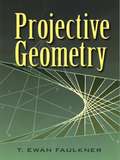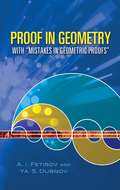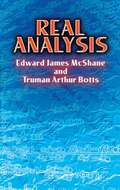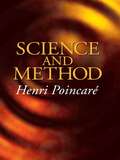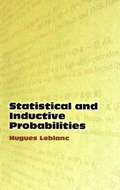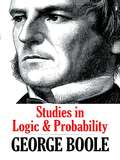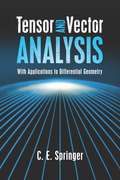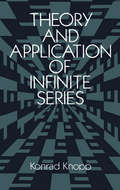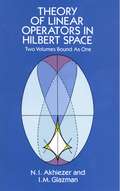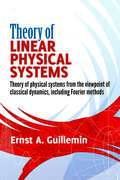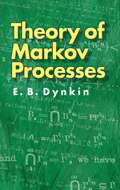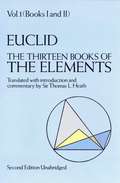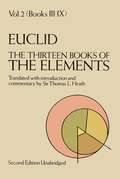- Table View
- List View
Projective Geometry
by T. Ewan FaulknerThis text explores the methods of the projective geometry of the plane. Some knowledge of the elements of metrical and analytical geometry is assumed; a rigorous first chapter serves to prepare readers. Following an introduction to the methods of the symbolic notation, the text advances to a consideration of the theory of one-to-one correspondence. It derives the projective properties of the conic and discusses the representation of these properties by the general equation of the second degree. A study of the relationship between Euclidean and projective geometry concludes the presentation. Numerous illustrative examples appear throughout the text.
Proof in Geometry: With "Mistakes in Geometric Proofs" (Dover Books on Mathematics)
by A. I. Fetisov Ya. S. DubnovThis single-volume compilation of two books explores the construction of geometric proofs. In addition to offering useful criteria for determining correctness, it presents examples of faulty proofs that illustrate common errors. High-school geometry is the sole prerequisite.Proof in Geometry, the first in this two-part compilation, discusses the construction of geometric proofs and presents criteria useful for determining whether a proof is logically correct and whether it actually constitutes proof. It features sample invalid proofs, in which the errors are explained and corrected.Mistakes in Geometric Proofs, the second book in this compilation, consists chiefly of examples of faulty proofs. Some illustrate mistakes in reasoning students might be likely to make, and others are classic sophisms. Chapters 1 and 3 present the faulty proofs, and chapters 2 and 4 offer comprehensive analyses of the errors.
Pythagorean Triangles (Dover Books on Mathematics)
by Waclaw SierpinskiThe Pythagorean Theorem is one of the fundamental theorems of elementary geometry, and Pythagorean triangles — right triangles whose sides are natural numbers — have been studied by mathematicians since antiquity. In this classic text, a brilliant Polish mathematician explores the intriguing mathematical relationships in such triangles.Starting with "primitive" Pythagorean triangles, the text examines triangles with sides less than 100, triangles with two sides that are successive numbers, divisibility of one of the sides by 3 or by 5, the values of the sides of triangles, triangles with the same arm or the same hypotenuse, triangles with the same perimeter, and triangles with the same area. Additional topics include the radii of circles inscribed in Pythagorean triangles, triangles in which one or more sides are squares, triangles with natural sides and natural areas, triangles in which the hypotenuse and the sum of the arms are squares, representation of triangles with the help of the points of a plane, right triangles whose sides are reciprocals of natural numbers, and cuboids with edges and diagonals expressed by natural numbers.
Real Analysis
by Truman Arthur Botts Edward James McShaneThis text offers upper-level undergraduates and graduate students a survey of practical elements of real function theory, general topology, and functional analysis. Beginning with a brief discussion of proof and definition by mathematical induction, it freely uses these notions and techniques. The maximality principle is introduced early but used sparingly; an appendix provides a more thorough treatment. The notion of convergence is stated in basic form and presented initially in a general setting. The Lebesgue-Stieltjes integral is introduced in terms of the ideas of Daniell, measure-theoretic considerations playing only a secondary part. The final chapter, on function spaces and harmonic analysis, is deliberately accelerated. Helpful exercises appear throughout the text. 1959 edition.
Recursive Analysis (Dover Books on Mathematics)
by R. L. GoodsteinRecursive analysis develops natural number computations into a framework appropriate for real numbers. This text is based upon primary recursive arithmetic and presents a unique combination of classical analysis and intuitional analysis. Written by a master in the field, it is suitable for graduate students of mathematics and computer science and can be read without a detailed knowledge of recursive arithmetic.Introductory chapters on recursive convergence and recursive and relative continuity are succeeded by explorations of recursive and relative differentiability, the relative integral, and the elementary functions. A final chapter examines transfinite ordinals, and the text concludes with a helpful appendix of topics related to recursive irrationality and transcendence.
A Refresher Course in Mathematics
by F. J. CammReaders wishing to renew and extend their acquaintance with a variety of branches of mathematics will find this volume a practical companion. Geared toward those who already possess some familiarity with its subjects, the easy-to-follow explanations and straightforward tone make this book highly accessible. The contents are arranged logically and in order of difficulty: fractions, decimals, square and cube root, the metric system, algebra, quadratic and cubic equations, graphs, and the calculus are among the topics. Explanations of mathematical principles are followed by worked examples, and the book includes a convenient selection of tables that cover the trigonometrical functions and logarithms necessary for completing some of the examples.
Reliability Theory and Practice
by Igor BazovskyWritten by a pioneer in the development of reliability methods, this text applies statistical mathematics to the analysis of electrical, mechanical, and other systems employed in airborne, missile, and ground equipment. Geared toward upper-level undergraduate and graduate students, it is also a valuable reference for professionals. 1961 edition.
Science and Method
by Henri PoincaréThis classic by the famous mathematician defines the basic methodology and psychology of scientific discovery, particularly regarding mathematics and mathematical physics. Drawing on examples from many fields, it explains how scientists analyze and choose their working facts, and it explores the nature of experimentation, theory, and the mind. 1914 edition.
Set Theory: The Structure Of Arithmetic (Dover Books on Mathematics)
by Norman T. Hamilton Joseph LandinThis text is formulated on the fundamental idea that much of mathematics, including the classical number systems, can best be based on set theory. Beginning with a discussion of the rudiments of set theory, authors Norman T. Hamilton and Joseph Landin lead readers through a construction of the natural number system, discussing the integers and the rational numbers, and concluding with an in-depth examination of the real numbers. Drawn from lecture notes for a course intended primarily for high school mathematics teachers, this volume was designed to answer the question, "What is a number?" and to provide a foundation for the study of abstract algebra, elementary Euclidean geometry, and analysis. Upon completion of this treatment — which is suitable for high school mathematics teachers and advanced high school students — readers should be well prepared for introductory courses in abstract algebra and real variables.
Sets, Sequences and Mappings: The Basic Concepts of Analysis
by Kenneth Anderson Dick Wick HallStudents progressing to advanced calculus are frequently confounded by the dramatic shift from mechanical to theoretical and from concrete to abstract. This text bridges the gap, offering a systematic development of the real number system and careful treatment of mappings, sequences, limits, continuity, and metric spaces.The first five chapters consist of a systematic development of many of the important properties of the real number system, plus detailed treatment of such concepts as mappings, sequences, limits, and continuity. The sixth and final chapter discusses metric spaces and generalizes many of the earlier concepts and results involving arbitrary metric spaces.An index of axioms and key theorems appears at the end of the book, and more than 300 problems amplify and supplement the material within the text. Geared toward students who have taken several semesters of basic calculus, this volume is an ideal prerequisite for mathematics majors preparing for a two-semester course in advanced calculus.
A Short Account of the History of Mathematics (Dover Books on Mathematics)
by W. W. BallThis is a new printing, the first inexpensive one, of one of the most honored histories of mathematics of all time. When the last revised edition appeared in 1908, it was hailed by mathematicians and laymen alike, and it remains one of the clearest, most authoritative, and most accurate works in the field. Mathematicians welcomed it as a lucid overview of the development of mathematics down through the centuries. Laymen welcomed it as a work which gave them an opportunity to understand the development of one of the most recondite and difficult of all intellectual endeavors, and the individual contributions of its great men.In this standard work, Dr. Ball treats hundreds of figures and schools that have been instrumental in the development of mathematics from the Egyptians and Phoenicians to such giants of the 19th century as Grassman, Hermite, Galois, Lie, Riemann, and many others who established modern mathematics as we know it today. This semi-biographical approach gives you a real sense of mathematics as a living science, but where Dr. Ball has found that the biographical approach is not sufficient or suited to presenting a mathematical discovery or development, he does not hesitate to depart from his major scheme and treat the mathematics in detail by itself. Thus, while the book is virtually a pocket encyclopedia of the major figures of mathematics and their discoveries, it is also one of the best possible sources for material on such topics as the problems faced by Greek mathematicians, the contributions of the Arab mathematicians, the development of mathematical symbolism, and the invention of the calculus.While some background in mathematics is desirable to follow the reference in some of the later sections, most of the book can be read without any more preparation than high school algebra. As a history of mathematics to browse through, or as a convenient reference work, it has never been excelled.
A Short Course in Automorphic Functions (Dover Books on Mathematics)
by Joseph LehnerThis concise three-part treatment introduces undergraduate and graduate students to the theory of automorphic functions and discontinuous groups. Author Joseph Lehner begins by elaborating on the theory of discontinuous groups by the classical method of Poincaré, employing the model of the hyperbolic plane. The necessary hyperbolic geometry is developed in the text. Chapter two develops automorphic functions and forms via the Poincaré series. Formulas for divisors of a function and form are proved and their consequences analyzed. The final chapter is devoted to the connection between automorphic function theory and Riemann surface theory, concluding with some applications of Riemann-Roch theorem. <p> The book presupposes only the usual first courses in complex analysis, topology, and algebra. Exercises range from routine verifications to significant theorems. Notes at the end of each chapter describe further results and extensions, and a glossary offers definitions of terms.
Singular Integral Equations: Boundary Problems of Function Theory and Their Application to Mathematical Physics
by N. I. MuskhelishviliSingular integral equations play important roles in physics and theoretical mechanics, particularly in the areas of elasticity, aerodynamics, and unsteady aerofoil theory. They are highly effective in solving boundary problems occurring in the theory of functions of a complex variable, potential theory, the theory of elasticity, and the theory of fluid mechanics.This high-level treatment by a noted mathematician considers one-dimensional singular integral equations involving Cauchy principal values. Its coverage includes such topics as the Hölder condition, Hilbert and Riemann-Hilbert problems, the Dirichlet problem, inversion formulas for arcs, and many other areas. Intended for graduate students, applied and pure mathematicians, engineers, physicists, and researchers in a variety of scientific and industrial fields, this text is accessible to students acquainted with the basic theory of functions of a complex variable and the theory of Fredholm integral equations.
A Source Book in Mathematics
by David Eugene SmithThis work presents, in English translation, the great discoveries in mathematics from the Renaissance to the end of the nineteenth century. You are able to read the writings of Newton, Leibniz, Pascal, Riemann, Bernoulli, and others, exactly as the world saw them for the first time. Succinct selections from 125 different treatises and articles, most of them unavailable elsewhere in English, offer a vivid, firsthand story of the growth of mathematics.
Speed Mathematics Simplified (Dover Books on Mathematics)
by Edward StoddardThis entertaining, easy-to-follow book is ideal for anyone who works with numbers and wants to develop greater speed, ease, and accuracy in doing mathematical calculations. In an inspiring introduction, science writer Edward Stoddard offers important suggestions for mastering an entirely new system of figuring. Without having to discard acquired information about mathematical computation, students build on the knowledge they already have, "streamline" these techniques for rapid use and then combine them with classic shortcuts.Initially, readers learn to master a basic technique known as the Japanese "automatic" figuring method — the principle behind the abacus. This method enables users to multiply without carrying, divide with half the written work of long division, and mentally solve mathematical problems that usually require pencil and paper or a calculator. Additional chapters explain how to build speed in addition and subtraction, how to check for accuracy, master fractions, work quickly with decimals, handle percentages, and much more. A valuable asset for people in business who work with numbers on a variety of levels, this outstanding book will also appeal to students, teachers, and anyone looking for a reliable way to improve skill and speed in doing basic arithmetic.
Spheroidal Wave Functions
by Carson FlammerIntended to facilitate the use and calculation of spheroidal wave functions, this applications-oriented text features a detailed and unified account of the properties of these functions. Addressed to applied mathematicians, mathematical physicists, and mathematical engineers, it presents tables that provide a convenient means for handling wave problems in spheroidal coordinates.Topics include separation of the scalar wave equation in spheroidal coordinates, angle and radial functions, integral representations and relations, and expansions in spherical Bessel function products. Additional subjects include recurrence relations of Whittaker type, asymptotic expansions for large values of c, and vector wave functions. The text concludes with an appendix, references, and tables of numerical values.
Statistical and Inductive Probabilities (Dover Books on Mathematics)
by Hugues LeblancAmong probability theorists, a bitter controversy has raged for decades between the adherents of John Maynard Keynes' A Treatise on Probability (1921) and those of Richard von Mises' "Grundlagen der Wahrscheinlichkeitsrechnung" (1919). Keynes declared that probabilities measure the extent to which a so-called evidence proposition supports another sentence. Von Mises insisted that they measure the relative frequency with which the members of a so-called reference set belong to another set. Statistical and Inductive Probabilities offers an evenhanded treatment of this issue, asserting that both statistical and inductive probabilities may be treated as sentence-theoretic measurements, and that the latter qualify as estimates of the former.Beginning with a survey of the essentials of sentence theory and of set theory, author Hugues Leblanc examines statistical probabilities (which are allotted to sets by von Mises' followers), showing that statistical probabilities may be passed on to sentences, and thereby qualify as truth-values. Leblanc concludes with an exploration of inductive probabilities (which Keynes' followers allot to sentences), demonstrating their reinterpretation as estimates of truth-values.Each chapter is preceded by a summary of its contents. Illustrations accompany most definitions and theorems, and footnotes elucidate technicalities and bibliographical references.
Studies in Logic and Probability (Dover Books on Mathematics)
by George BooleFrom one of the founders of symbolic logic comes this collection of writings on logical subjects and related questions of probability. George Boole invented Boolean logic, the basis of modern digital computer logic, for which he is regarded as a founder of the field of computer science. This authoritative compilation of his papers features his most mature thinking on Boolean logic and includes previously unpublished material.Appropriate for upper-level undergraduates and graduate students, the contents range from The Mathematical Analysis of Logic to Boole's final works, including The Laws of Thought, the most systematic statement of his ideas on logic and probability. Boole had intended to create a follow-up volume but did not survive to fulfill his ambition; this volume features his further studies on the subject.
Tensor and Vector Analysis: With Applications to Differential Geometry (Dover Books on Mathematics)
by C. E. SpringerConcise and user-friendly, this college-level text assumes only a knowledge of basic calculus in its elementary and gradual development of tensor theory. The introductory approach bridges the gap between mere manipulation and a genuine understanding of an important aspect of both pure and applied mathematics.Beginning with a consideration of coordinate transformations and mappings, the treatment examines loci in three-space, transformation of coordinates in space and differentiation, tensor algebra and analysis, and vector analysis and algebra. Additional topics include differentiation of vectors and tensors, scalar and vector fields, and integration of vectors. The concluding chapter employs tensor theory to develop the differential equations of geodesics on a surface in several different ways to illustrate further differential geometry.
Theory and Application of Infinite Series (Dover Books on Mathematics)
by Konrad KnoppThis classic work, written in a clear and interesting style, with many exercises, offers a thorough and reliable treatment of an important branch of higher analysis. It lends itself well to use in course work; however, because of its consistent clear illustrations of theoretical difficulties, the book is also ideal for self-study.Since all higher analysis depends on the theory of numbers, Professor Knopp (formerly Professor of Mathematics, University of Tübingen) begins with an introduction to the theory of real numbers, an indispensable foundation for what is to come. This introduction is followed by an extensive account of the theory of sequences and the actual theory of infinite series. The latter is covered in two stages: (1) the classical theory (2) later developments of the 19th century.Carefully selected exercises have been included throughout, emphasizing applications of the theory, rather than purely theoretical considerations.Aimed at students already acquainted with the elements of differential and integral calculus, this work grew out of the author's lectures and course work at the universities of Berlin and Königsberg. This pedagogical background helped him achieve a work of utmost clarity and precision — one that belongs in the library of every serious mathematician or student of higher analysis.
Theory of Linear Operators in Hilbert Space
by I. M. Glazman N. I. AkhiezerThis classic textbook by two mathematicians from the USSR's prestigious Kharkov Mathematics Institute introduces linear operators in Hilbert space, and presents in detail the geometry of Hilbert space and the spectral theory of unitary and self-adjoint operators. It is directed to students at graduate and advanced undergraduate levels, but because of the exceptional clarity of its theoretical presentation and the inclusion of results obtained by Soviet mathematicians, it should prove invaluable for every mathematician and physicist. 1961, 1963 edition.
Theory of Linear Physical Systems: Theory of physical systems from the viewpoint of classical dynamics, including Fourier methods
by Ernst A. GuilleminAn eminent electrical engineer and authority on linear system theory takes upper-level undergraduates and graduate students beyond the average introductory circuits course, providing them with additional background for understanding advanced network synthesis. This sophisticated treatise broadens students' understanding of the topological and algebraic relations for establishing equilibrium equations and transformations between sets of variables. The text further examines energy functions in both active and passive situations as well as important properties of impedance and similar characterizing functions.The treatment also explores the evaluation and prediction of approximation and truncation errors attendant upon the use of numerical methods of direct and inverse Fourier transform evaluation; the properties of partial sums; and the interpretation of limit processes. In addition, the text stresses the relation between the Fourier and Laplace methods and the approach in classical dynamics, basing the evaluation of Fourier integrals upon meaningful physical reasoning and providing an effective tool for dealing with special problems from the viewpoint of classical dynamics.
Theory of Markov Processes (Dover Books on Mathematics)
by E. B. Dynkin D. E. Brown T. KovaryAn investigation of the logical foundations of the theory behind Markov random processes, this text explores subprocesses, transition functions, and conditions for boundedness and continuity. Rather than focusing on probability measures individually, the work explores connections between functions. An elementary grasp of the theory of Markov processes is assumed.Starting with a brief survey of relevant concepts and theorems from measure theory, the text investigates operations that permit an inspection of the class of Markov processes corresponding to a given transition function. It advances to the more complicated operations of generating a subprocess, followed by examinations of the construction of Markov processes with given transition functions, the concept of a strictly "Markov process," and the conditions required for boundedness and continuity of a Markov process. Addenda, notes, references, and indexes supplement the text.
The Thirteen Books of the Elements (Dover Books on Mathematics #1)
by EuclidThis is the definitive edition of one of the very greatest classics of all time — the full Euclid, not an abridgement. Using the text established by Heiberg, Sir Thomas Heath encompasses almost 2,500 years of mathematical and historical study upon Euclid.This unabridged republication of the original enlarged edition contains the complete English text of all 13 books of the Elements, plus a critical apparatus that analyzes each definition, postulate, and proposition in great detail. It covers textual and linguistic matters; mathematical analyses of Euclid’s ideas; classical, medieval, Renaissance, modern commentators; refutations, supports, extrapolations, reinterpretations, and historical notes, all given with extensive quotes.“The textbook that shall really replace Euclid has not yet been written and probably never will be.” — Encyclopaedia Britannica.Volume 1. 151-page Introduction: life and other works of Euclid; Greek and Islamic commentators; surviving mss., scholia, translations; bases of Euclid’s thought. Books I and II of the Elements, straight lines, angles, intersection of lines, triangles, parallelograms, etc.
The Thirteen Books of the Elements: Books Iii-ix (classic Reprint) (Dover Books on Mathematics #2)
by EuclidThis is the definitive edition of one of the very greatest classics of all time — the full Euclid, not an abridgement. Using the text established by Heiberg, Sir Thomas Heath encompasses almost 2,500 years of mathematical and historical study upon Euclid.This unabridged republication of the original enlarged edition contains the complete English text of all 13 books of the Elements, plus a critical apparatus that analyzes each definition, postulate, and proposition in great detail. It covers textual and linguistic matters; mathematical analyses of Euclid’s ideas; classical, medieval, Renaissance, modern commentators; refutations, supports, extrapolations, reinterpretations, and historical notes, all given with extensive quotes. Volume 1. 151-page Introduction: life and other works of Euclid; Greek and Islamic commentators; surviving mss., scholia, translations; bases of Euclid’s thought. Books I and II of the Elements, straight lines, angles, intersection of lines, triangles, parallelograms, etc.Volume 2. Books III-IX: Circles, tangents, segments, figures described around and within circles, rations, proportions, magnitudes, polygons, prime numbers, products, plane and solid numbers, series of rations, etc.Volume 3. Books X to XIII: planes, solid angles, etc.; method of exhaustion in similar polygons within circles, pyramids, cones, cylinders, spheres, etc. Appendix: Books XIV, XV, sometimes ascribed to Euclid.
